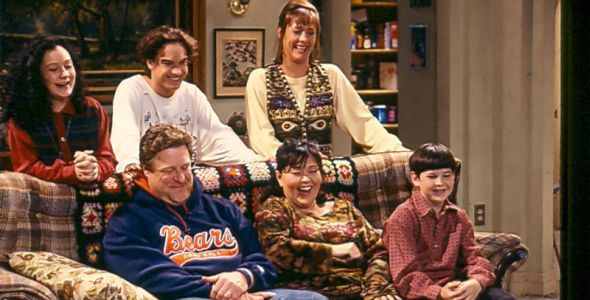Next Question: Do You Consider Yourself Middle Class?

Would the Conners, with their multi-story home, still be considered “working class” in 2015?
I hope you all read Ester’s earlier post on how to determine whether you are financially secure. According to Time’s criteria, I am financially secure: I am in control of my day-to-day and month-to-month finances, I have enough savings to absorb a financial setback (see: unexpected taxes, unexpected leaky pipes), I am on track to meet my financial goals (slowly but surely), and I have the freedom to make choices that help me enjoy life.
But I don’t feel financially secure. Probably because I live in a microapartment where I wash my dishes in a bus tub. To me, financial security means everything Time listed and something more; something akin to what I think a professional in her 30s who is fairly well established in her career should have. A one-bedroom apartment, a proper kitchen, comfortable furniture and a space to host guests.
In short, I want to be middle class.
Am I middle class already? Are you? That’s the question The Atlantic asks us to consider, citing data that indicates a higher percentage of Americans are choosing to identify as working or lower class, even if they earn what is considered a middle-class income:
According to a recent survey from Gallup, about 51 percent of Americans consider themselves middle or upper-middle class, while 48 percent consider themselves working or lower class. That’s the highest share to identify themselves as being on the lower rungs of the socioeconomic ladder since Gallup began gathering such data in 2000, and a big drop-off from earlier periods, when as much as 63 percent of respondents considered themselves to be middle class.
Looking more closely at the Gallup survey data reveals that, in the seven years (and one Great Recession) since 2008, 15 percent fewer Americans age 30–49 identify as middle class or upper middle class, as do 16 percent fewer Americans age 50–64. This data implies that a not insignificant number of Americans feel like they moved into a lower economic class following the recession.
One of the reasons these types of surveys ask what class people feel like they belong to, rather than simply calculating what income they earn, is because the definition of a middle-class income is so broad. As The Atlantic explains:
One of the more common methods for identifying the “middle class” is to simply define it as the half of the population making more than the bottom quarter and less than the top quarter. In 2013, such rankings would consider households with income between about $24,000 to $90,000 middle class, based on data from the Survey of Consumer Finances. With a more comprehensive wealth measure — taking into consideration not only income, but total assets and liabilities — this middle 50 percent of Americans covers an enormous range: families who have anywhere between about $9,000 to $317,000. Which is pretty crazy given the vastly different realities of families on either end of those spectrums.
It is very hard for me not to identify as middle class. I come from a middle-class background (college-educated parents who owned their own home, etc.), I have a college degree and a MFA, and the majority of people I interact with on a daily basis are middle class. I earn a clear middle-class income, especially for a single person, especially when you consider that the median US income in 2014 was $53,891. Although my life and home feel less comfortable and more stingy than I imagined they might be, calling myself “working class” would deny both the privileges I had in my childhood and the privileges I currently have.
So I have to say that I am middle class, and that this is what a middle-class life looks like.
What about you?
Support The Billfold
The Billfold continues to exist thanks to support from our readers. Help us continue to do our work by making a monthly pledge on Patreon or a one-time-only contribution through PayPal.
Comments